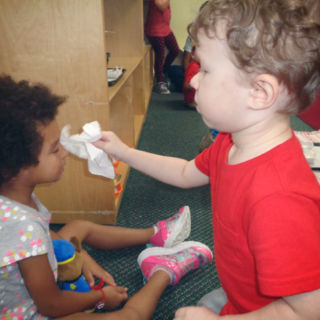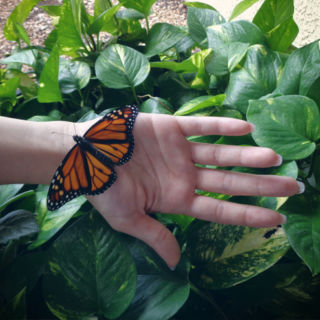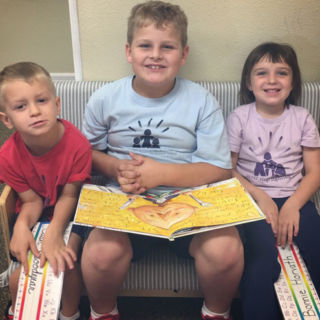
These lessons are specifically organized and conducted in a particular sequence that mirrors the acquisition of children’s knowledge. Lessons first flow from encoding symbols (letters). The phonetic sound rather than the letter name is emphasized. Then decoding of letter combinations (words) comes next. Advanced lessons for older children teach grammar and build vocabulary. You can give your child a boost in language by naming items at home or while traveling, using proper language, playing rhyming games or “I Spy,” and by reading books together.
A detailed explanation of the curriculum at each stage of development is provided here in an article by Michelle Irinyi from the NAMC Montessori Teacher Training Blog at http://montessoritraining.blogspot.com/2010/06/montessori-language-arts-curriculum.html
Montessori Curriculum Explained: Language Arts Materials, Activities and Philosophy
Language is the central point of difference between the human species and all others. Language lies at the root of that transformation of the environment that we call civilization…Language is an instrument of collective thought…Hence, language is truly the expression of a kind of super intelligence.
— Maria Montessori, The Absorbent Mind.
Montessori believed that language is innate and it is in the nature of humans to express themselves both orally and through the written word. The Montessori Language Arts curriculum, therefore, starts the moment the child first enters the environment. Enjoy this in depth look as we explain Montessori Language Arts curriculum materials, activities, and philosophy.
Montessori Language: Ages 0-3
Montessori believed that the sensitive period for language begins at birth and continues to about six years of age. From birth, the child has been absorbing the sounds and speech patterns of family and home environment. Long before being able to speak, the child listened intently while acquiring the sounds of her native language. Babies learn to recognize and repeat the individual sounds of their language and toddlers learn to recognize, name, and pronounce the names of objects in their environment. In the Montessori Infant/Toddler environment, daily exposure to language through conversations and the reading of good literature helps the child strengthen her vocabulary and increases independence as she becomes more cognizant of the world around her, giving her the ability to name her wishes and desires.
Montessori Language: Ages 3-6
The Montessori 3-6 classroom is a natural extension of the patterns of communication that have already been absorbed. Through every conversation, every book read aloud, every new word that is taught, the Montessori student is learning language, and thus, learning to read. In the Montessori Preschool/Kindergarten environment, emphasis is placed on the process of acquiring language. Knowledge is constructed by mental and physical activity rather than on passive learning. Writing is taught before reading through the direct and indirect aims of the Montessori Practical Life and Sensorial works. In the Montessori 3-6 Language curriculum, writing itself is seen as a direct preparation for reading.
Montessori parents and educators use precise language that is neither too simplified or given to baby-talk in order to give credence to the work the child is doing to acquire vocabulary and language skills. As Montessori educators, we help the child to focus her attention to the sound of her own speech, making fine distinctions between sounds. From our attention in oral language development emerges the child’s need to write. Written symbols are introduced and from there, the child bursts spontaneously into reading.
Montessori Language: Ages 6-12
From infancy, children have learned the names of things. In the lower elementary Montessori classroom, students begin to analyze more abstract concepts of language: the how, the why, and the from where? Montessori elementary students explore the history of language, written language, spoken language, literature and grammar, and syntax.
The Montessori Fourth Great Lesson is the story of how writing began. This impressionistic story grabs the attention of young students who are eager to learn about those who came before us. From there, they listen to and read great literature and are further motivated to tell their own stories through creative writing, reports, drama, poetry, and song.
Throughout this work, Montessori students are introduced to the rules of human communication through word studies, work with the Montessori Grammar Boxes, as well as beginning logical sentence analysis. The goal in the Montessori elementary Language curriculum is not to teach grammar but to give a concrete representation and foster a love of the function of words.
Dr. Montessori described the role of language in traditional education as forcing children speak and write when they have nothing to say. She said instead, that “The child must create his interior life before he can express anything; he must take spontaneously from the external world constructive material in order to ‘compose’; he must exercise his intelligence fully before he can be ready to find the logical connection between things. We ought to offer the child that which is necessary for his internal life and leave him free to produce.” (Spontaneous Activity in Education). By unlimited exposure in the Montessori environment, we free the child’s creative and imaginative process, giving her the means to write and tell her own story.



